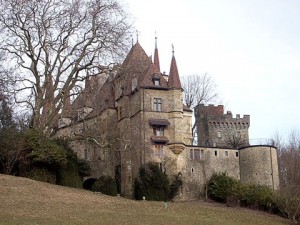 I first tasted Absinthe at my family’s Château de Gorgier, situated in the small village of Gorgier, Switzerland not far from Neuchâtel, in the mid seventies. My mother’s cousin was making it in one of the cellars, I presume, illegally. I remember it tasting similar to Pastis with a slightly different note. We had a glass or two before going to lunch at a restaurant on the lake and it gave quite a quick buzz.
I first tasted Absinthe at my family’s Château de Gorgier, situated in the small village of Gorgier, Switzerland not far from Neuchâtel, in the mid seventies. My mother’s cousin was making it in one of the cellars, I presume, illegally. I remember it tasting similar to Pastis with a slightly different note. We had a glass or two before going to lunch at a restaurant on the lake and it gave quite a quick buzz.
 A chemist by the name of Ted Breaux has spent years perfecting absinthe making in Europe based on the original pre-ban recipes. He has meticulously recreated genuine Absinthe as is it is meant to be. In so doing he also managed to refine it to the point where the Thujone (the harmful element in wormwood) was virtually non-existent. Thujone is the ingredient that is banned in the U.S. and many other countries. The ban was lifted because this ingredient has been removed from the product. According to Ted, that is the way it was in the 1800’s. However, they have balanced the herbs differently in an effort to make it less pungent for the American market. I believe that the Spanish or Swiss Absinthe would be preferable.
A chemist by the name of Ted Breaux has spent years perfecting absinthe making in Europe based on the original pre-ban recipes. He has meticulously recreated genuine Absinthe as is it is meant to be. In so doing he also managed to refine it to the point where the Thujone (the harmful element in wormwood) was virtually non-existent. Thujone is the ingredient that is banned in the U.S. and many other countries. The ban was lifted because this ingredient has been removed from the product. According to Ted, that is the way it was in the 1800’s. However, they have balanced the herbs differently in an effort to make it less pungent for the American market. I believe that the Spanish or Swiss Absinthe would be preferable.
 Lucid Absinthe is an American product, which started production in 2006 and is distilled by Viridian Spirits in Manhasset, New York and was founded in 2006. According to Viridian’s president, the first thing the company did was to contact Ted Breaux, a chemist known for his detailed analyses of vintage absinthes.
Lucid Absinthe is an American product, which started production in 2006 and is distilled by Viridian Spirits in Manhasset, New York and was founded in 2006. According to Viridian’s president, the first thing the company did was to contact Ted Breaux, a chemist known for his detailed analyses of vintage absinthes.
According to records Absinthe was created in Val-de-Travers, Switzerland. Since 1915, it was prohibited in a number of European countries and the United States.
Absinthe was available in five different grades: “ordinaire”,”demi-fine”,”fine”,”supérieure” and “Suisse” (this title does not refer to the country), in order of increasing alcoholic strength and quality. A “supérieure” and “Suisse” would always be naturally colored and distilled. “Ordinaire” and “demi-fine” might be artificially colored and made from oil extracts.
 Man drinking absinthe and eventually the “green fairy” appears
Man drinking absinthe and eventually the “green fairy” appears

